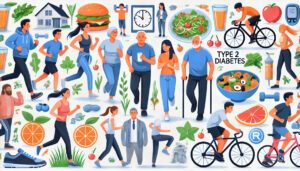Introduction
Type 2 diabetes is a widespread condition affecting millions worldwide, yet it remains shrouded in misconceptions. Accurate information is crucial for effective management and prevention. Misunderstandings can lead to stigma and hinder people from seeking proper care. Let’s debunk some of the most common myths about Type 2 diabetes with facts.
I was diagnosed with type 2 diabetes shortly after I quit smoking, started regular exercise and turned 40 years old. The “over-weight and over-40” prophesy seemed to be upon me.
Myth 1: Type 2 Diabetes Is Only for the Elderly
The Reality
Type 2 diabetes is often associated with older adults, but this stereotype is misleading. Statistics and studies show a significant increase in Type 2 diabetes among younger populations. According to the Centers for Disease Control and Prevention (CDC), approximately 193,000 Americans under 20 years old are diagnosed with diabetes, with a growing number of Type 2 cases.
From my extensive reading on this subject, it has greatly to do with our fast lifestyles of eating so many processed foods.
Factors at Play
The onset of Type 2 diabetes in younger individuals can be attributed to a combination of lifestyle and genetic factors. Poor diet, lack of physical activity, and obesity are contributing factors, but genetics also play a crucial role. Family history can increase the risk, making some individuals more susceptible regardless of age.
Real-Life Stories
Consider Sarah, a 24-year-old college student diagnosed with Type 2 diabetes at 18. Despite maintaining a healthy weight, her family history and sedentary lifestyle contributed to her condition. Sarah’s story highlights the importance of awareness and proactive health management for all age groups.
Myth 2: Type 2 Diabetes Can Be Cured Solely by Diet and Exercise
The Reality
While a healthy diet and regular exercise are critical components of diabetes management, they are not a cure. Type 2 diabetes is a chronic condition that requires ongoing management.
On a personal note, I do believe that through proper diet and exercise type 2 diabetes can be put into what some doctors call “remission.” To me, remission is a reversal of the type 2 diagnosis. Not everyone is in agreement on this and it is a very controversial topic.
The Importance of Medical Intervention
Diet and exercise help manage blood sugar levels and overall health, but many individuals need additional medical intervention. Medications, including oral drugs and sometimes insulin, are often necessary to maintain optimal blood glucose levels.
The Bigger Picture
This myth oversimplifies a complex condition. It’s crucial to recognize that diabetes management involves a comprehensive approach, including medical treatment, lifestyle changes, and regular monitoring.
Myth 3: Insulin Use Means Your Diabetes is Severe
The Reality
Insulin therapy is a common and effective treatment for Type 2 diabetes, but its use does not necessarily indicate severe disease. Insulin helps manage blood glucose levels when the body cannot produce enough insulin or effectively use what it makes.
My friend who suffers from type 1 diabetes calls insulin a “fat magnet!” She said that it is like the insulin “attracts fat to our stomachs.” It is probably a combination of things, but since I started on insulin, I tend to agree with her! It seems like all my weight accumulates in my stomach these days.
Treatment Progression
Type 2 diabetes is progressive. Over time, the pancreas may produce less insulin, making insulin therapy necessary. This progression is a natural part of the disease, not a sign of failure or severity.
Addressing Stigma
The stigma around insulin use can prevent people from accepting necessary treatment. Understanding that insulin is a tool for better management can help reduce this stigma. Many people live healthy, active lives while using insulin.
Myth 4: Only Overweight People Get Type 2 Diabetes
The Reality
While being overweight is a significant risk factor for Type 2 diabetes, it is not the sole determinant. Many other factors, including genetics, ethnicity, and age, contribute to the risk.
Beyond Body Weight
Skinny individuals can and do develop Type 2 diabetes. Research has shown that people of certain ethnicities, such as South Asians and African Americans, are at higher risk even at lower body weights. This highlights the complexity of diabetes and the need for a holistic view of health.
Promoting Holistic Health
Focusing solely on weight overlooks other critical aspects of health. A holistic approach considers diet, exercise, genetics, and overall lifestyle. Encouraging comprehensive health assessments can help identify and manage diabetes risk factors more effectively.
Conclusion
Understanding the facts about Type 2 diabetes is essential for effective management and prevention. Dispelling common myths can help reduce stigma and encourage better health practices. By promoting accurate information, we can support those affected by diabetes in leading healthier lives.
For more information, resources, and support, visit our website at diabeteshealthnuts.com and join our community dedicated to living well with diabetes.






